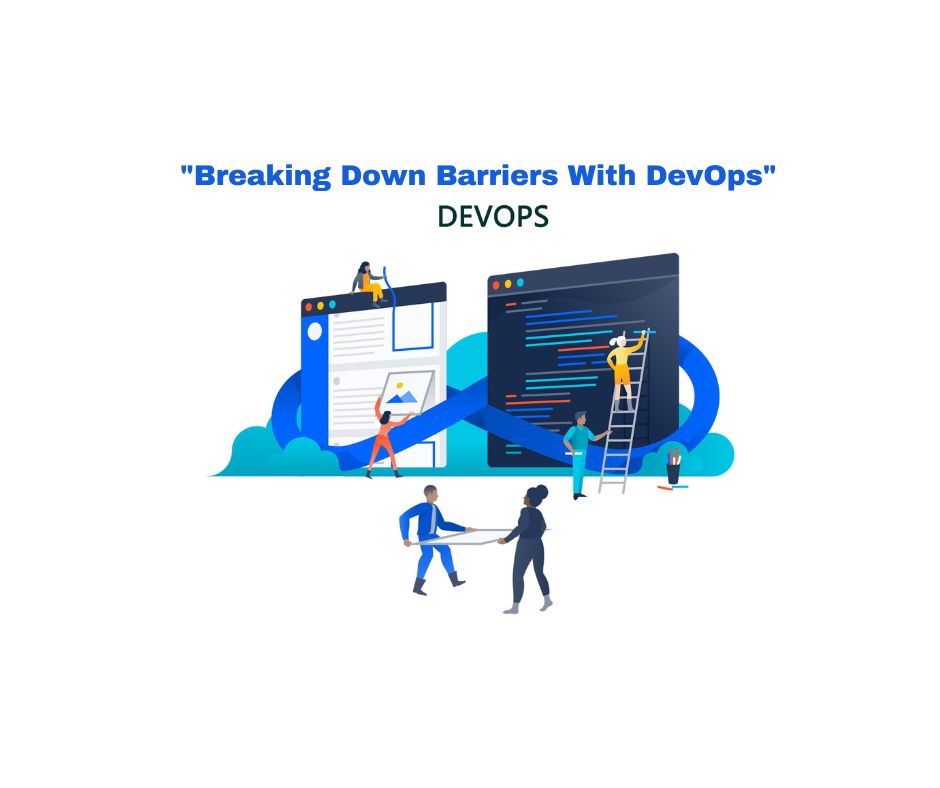Why DevOps? and Breaking Down Barriers With DevOps
Why DevOps?
DevOps is a term that has been growing in popularity in recent years. DevOps is short for Development Operations and refers to the process of integrating software development with IT operations. DevOps is based on the idea that delivery of applications and services can be improved by bringing together the development teams with the IT operations teams. This integration allows for faster delivery, increased collaboration between developers and IT ops, easier integration of new technology, improved efficiency and scalability, greater control of development processes, increased cloud capabilities, reduced overhead costs, and improved service quality and customer satisfaction.
DevOps is becoming more important as businesses move towards a more digital world. By bringing together these two groups – developers who create the applications and the people who manage the infrastructure – Devops can help to speed up deployment times, increase transparency between development and operations teams, simplify integration of new technology into an application or system, improve overall coordination between developers and IT ops staffs, enable better use of cloud-based resources when needed, reduce management costs associated with application deployment strategies, increase customer satisfaction because applications are delivered on time or even ahead of schedule relative to traditional methodsologies such as waterfall or blue/green deployments (where changes are made one at a time), provide scalability when needed (due to multiple servers being used rather than a single large server), etc.
In short:DEVOPS provides an integrated approach to developing applications that makes it easier for everyone involved – from Software Developers through Infrastructure Administrators all the way to Operations Staff – working together as one team towards a common goal.
Overcoming Challenges To Invest In DevOps Transformations
DevOps transformations can have a dramatic impact on an organization’s performance and customer satisfaction. Many organizations are still trying to figure out the best way to implement these changes, and many are facing challenges that they may not be able to overcome. In this blog, we will outline some of the benefits of implementing a devops culture, as well as the challenges that organizations face when transitioning to DevOps. We will also provide different strategies for overcoming and understanding legacy issues, as well as integrating automation and monitoring capabilities into the system. Finally, we will discuss how clustering techniques are used in DevOps to optimize performance and enhance visibility, scalability and agility within the organization. By understanding these challenges and strategies, you can successfully implement your own devops transformation! The DevOps Training in Hyderabad program by Kelly Technologies can help to develop the skills needed to handle the tools and techniques associated with DevOps.
Communication & Collaboration
In today’s fast-paced world, communication and collaboration are essential to success. DevOps is a rapidly growing trend within the software development industry that focuses on improving communication and collaboration between teams. DevOps is a collaborative process that helps to automate the deployment process, improve consistency between development and operations teams, and maximize the efficiency of software development. The DevOps Training in Hyderabad program by Kelly Technologies can help to develop the skills needed to handle the tools and techniques associated with DevOps.
There are many benefits to using DevOps for communication and collaboration within your team. For example, by automating the deployment process, you can ensure that your software is always up-to-date and bug-free. Additionally, by establishing effective communication channels between teams, you can minimize conflicts and ensure that all stakeholders are on the same page. This increased efficiency leads to better product outcomes for both development and operations teams.
To help you achieve even greater results with your team’s communication and collaboration efforts, consider using version control systems like Git or SVN. These systems help to track changes throughout the entire software development lifecycle, from concept to launchpad stage to production. This enables everyone involved in a project to understand what has changed and why – making collaboration much easier overall.
In addition, it’s important to keep track of progress in all areas of a project using digital dashboards or status boards. By monitoring these tools constantly, you can quickly identify issues before they become too big or complicated to address effectively. And last but not least – don’t forget about automated testing! By deploying tests alongside your codebase every time you make changes, you can ensure that everything works as it should when it goes live into production. Taken together, these tools provide an effective way for all members of a team to communicate with each other consistently and collaboratively – resulting in better outcomes for everyone involved!
Breaking Through Silos With DevOps Tools
As software development has become more complex, it’s become difficult for Dev and Ops teams to work together harmoniously. In order to improve collaboration and create a cohesive environment, it’s important to use DevOps tools. These tools help to automate processes and streamline workflow, which in turn increases efficiency and reduces errors. By using these strategies, you can break through silos and create a more effective enginee.
Automation & Continuous Integration
One of the most important aspects of any business is ensuring that it’s able to keep up with the ever-changing trends and technologies. With automation and continuous integration, businesses are able to do just that by taking on more responsibilities and tasks themselves. Automation in IT processes allows businesses to focus on their core functions while letting technology take care of the grunt work. Below, we’ll take a look at some of the benefits of DevOps for business.
First and foremost, DevOps helps businesses save time and money. By automating many common tasks, businesses are able to reduce the amount of time needed for routine tasks such as software development or system administration. This saving can be significant, especially when you consider how quickly technology changes these days.
Another benefit of DevOps is its ability to improve security and scalability. By automating various IT processes, businesses are able to increase security by identifying potential vulnerabilities earlier and fixing them before they become an issue. In addition, automated processes can help scale a company’s infrastructure by allowing for faster deployment times and increased flexibility in terms of system configuration.
Despite these benefits, there are still some challenges that must be overcome when implementing automation into your business process. For example, ensuring that all stakeholders are on board with the changes can be difficult – but this is where best practices come into play! Following guidelines such as automated testing can help mitigate any potential risks while ensuring that your software development process remains reliable and secure.
Overall, DevOps is an important step forward for any business looking to stay ahead of the curve in today’s market economy. By implementing automation into your workflow, you’re guaranteed improved efficiency and cost savings – two key factors in any successful business plan.
Streamlining Software Delivery With Devops Practices
Software delivery is a complex and challenging process. It’s essential that the process is done correctly in order to ensure that the software is delivered on time, within budget, and with the required quality levels. However, achieving this goal can be difficult due to the number of different stakeholders involved and the various legacy systems that must be integrated into the delivery process.
DevOps is a set of practices and tools that help to streamline software delivery. DevOps practices promote collaboration between different teams and simplify the deployment process by automating many of the tasks. By using automation, you can reduce errors and speed up your development cycle. This way, you can deliver high-quality software faster and at a lower cost than traditional methods.
Below, we’ll take a look at some of the benefits of using Devops for software delivery. We’ll also outline some of the tools and processes that are used in order to implement DevOps practices into an organization’s development environment. Finally, we’ll discuss how DevOps can be integrated into existing IT infrastructure so that it has maximum impact throughout an organization’s development processes.
Monitoring In Real Time
Monitoring is an essential part of any DevOps practice, and it’s important to understand the benefits of utilizing these practices in order to achieve optimum performance. By monitoring in real time, you can detect problems and issues early on, which can save you time and money.
One of the biggest benefits of using DevOps practices is that you can quickly deploy changes without having to wait for a manual approval process. This allows you to swiftly fix any issues that arise, and it also leads to improved quality assurance (QA) and product development (PD) processes. However, there are also some challenges associated with monitoring in real time. For example, measuring real-time metrics can be difficult and subjective. It’s important to find the right balance between automation and manual processes in order to achieve optimal results.
If you’re serious about adopting DevOps practices, then it’s important to have a comprehensive understanding of unified tooling (UT). UT enables developers to work on the same codebase from different platforms – such as Windows, MacOSx, or Linux – without having to use separate tools for each platform. This leads to improved collaboration between team members and faster software development cycles. However, there are also potential drawbacks associated with UT – such as increased complexity or cost. It’s important to find the right balance between using UT and unif so that you don’t compromise your software’s quality or performance.
In addition to monitoring data, another essential aspect of a successful DevOps practice is QA/testing efforts. By testing your software before release, you can ensure that it meets all your specific requirements before going live. However, testing in real time presents its own set of challenges: because tests run continuously rather than once per release cycle like traditional unit tests do., they tend not be able to detect certain types of errors as quickly or accurately as unit tests would be able To address this issue by leveraging CI/CD pipelines where automated builds run automated tests after code commits are made into source control repositories.
This article in the easybusinesstricks must have given you a clear idea about DevOps industry. However even with all these advances monitoring still poses certain unique challenges which cannot be solved by just installing some extra sensors on machines 。such as understanding what type metrics matter most for your organization at this moment? What data will give meaningful insights? In order not fall behind during these rapidly changing times we need better ways not just monitor but act upon what we see.











